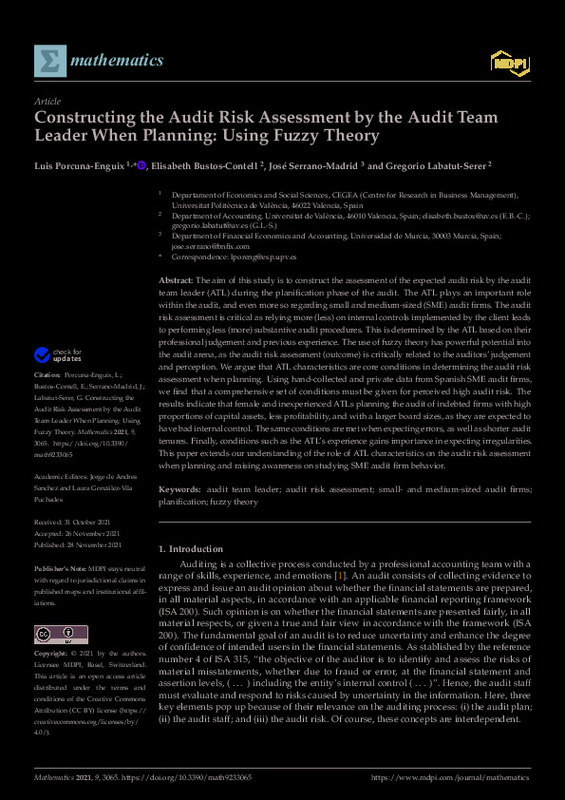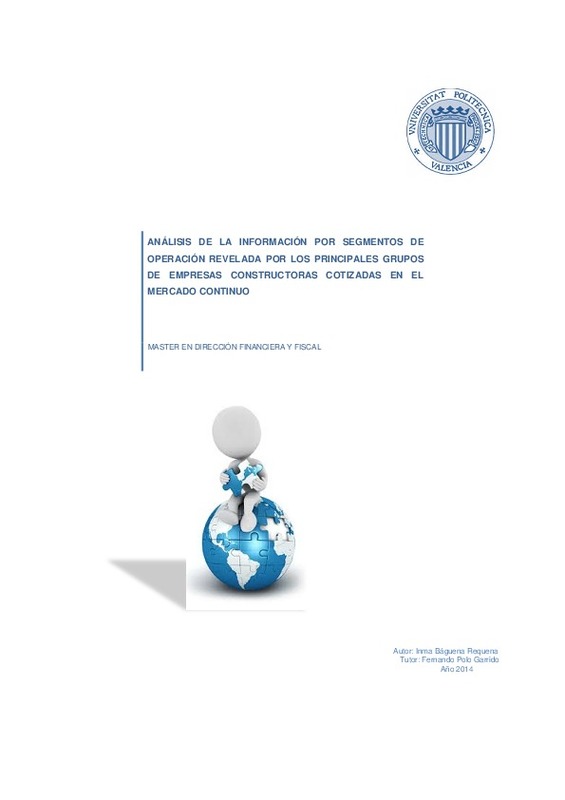JavaScript is disabled for your browser. Some features of this site may not work without it.
Buscar en RiuNet
Listar
Mi cuenta
Estadísticas
Ayuda RiuNet
Admin. UPV
Constructing the Audit Risk Assessment by the Audit Team Leader When Planning: Using Fuzzy Theory
Mostrar el registro sencillo del ítem
Ficheros en el ítem
| dc.contributor.author | Porcuna-Enguix, Luis
|
es_ES |
| dc.contributor.author | Bustos-Contell, Elisabeth
|
es_ES |
| dc.contributor.author | Serrano-Madrid, J.
|
es_ES |
| dc.contributor.author | Labatut-Serer, G.
|
es_ES |
| dc.date.accessioned | 2022-09-27T18:04:08Z | |
| dc.date.available | 2022-09-27T18:04:08Z | |
| dc.date.issued | 2021-11 | es_ES |
| dc.identifier.uri | http://hdl.handle.net/10251/186633 | |
| dc.description.abstract | [EN] The aim of this study is to construct the assessment of the expected audit risk by the audit team leader (ATL) during the planification phase of the audit. The ATL plays an important role within the audit, and even more so regarding small and medium-sized (SME) audit firms. The audit risk assessment is critical as relying more (less) on internal controls implemented by the client leads to performing less (more) substantive audit procedures. This is determined by the ATL based on their professional judgement and previous experience. The use of fuzzy theory has powerful potential into the audit arena, as the audit risk assessment (outcome) is critically related to the auditors' judgement and perception. We argue that ATL characteristics are core conditions in determining the audit risk assessment when planning. Using hand-collected and private data from Spanish SME audit firms, we find that a comprehensive set of conditions must be given for perceived high audit risk. The results indicate that female and inexperienced ATLs planning the audit of indebted firms with high proportions of capital assets, less profitability, and with a larger board sizes, as they are expected to have bad internal control. The same conditions are met when expecting errors, as well as shorter audit tenures. Finally, conditions such as the ATL's experience gains importance in expecting irregularities. This paper extends our understanding of the role of ATL characteristics on the audit risk assessment when planning and raising awareness on studying SME audit firm behavior. | es_ES |
| dc.language | Inglés | es_ES |
| dc.publisher | MDPI AG | es_ES |
| dc.relation.ispartof | Mathematics | es_ES |
| dc.rights | Reconocimiento (by) | es_ES |
| dc.subject | Audit team leader | es_ES |
| dc.subject | Audit risk assessment | es_ES |
| dc.subject | Small- and medium-sized audit firms | es_ES |
| dc.subject | Planification | es_ES |
| dc.subject | Fuzzy theory | es_ES |
| dc.subject.classification | ECONOMIA FINANCIERA Y CONTABILIDAD | es_ES |
| dc.title | Constructing the Audit Risk Assessment by the Audit Team Leader When Planning: Using Fuzzy Theory | es_ES |
| dc.type | Artículo | es_ES |
| dc.identifier.doi | 10.3390/math9233065 | es_ES |
| dc.rights.accessRights | Abierto | es_ES |
| dc.contributor.affiliation | Universitat Politècnica de València. Departamento de Economía y Ciencias Sociales - Departament d'Economia i Ciències Socials | es_ES |
| dc.description.bibliographicCitation | Porcuna-Enguix, L.; Bustos-Contell, E.; Serrano-Madrid, J.; Labatut-Serer, G. (2021). Constructing the Audit Risk Assessment by the Audit Team Leader When Planning: Using Fuzzy Theory. Mathematics. 9(23):1-22. https://doi.org/10.3390/math9233065 | es_ES |
| dc.description.accrualMethod | S | es_ES |
| dc.relation.publisherversion | https://doi.org/10.3390/math9233065 | es_ES |
| dc.description.upvformatpinicio | 1 | es_ES |
| dc.description.upvformatpfin | 22 | es_ES |
| dc.type.version | info:eu-repo/semantics/publishedVersion | es_ES |
| dc.description.volume | 9 | es_ES |
| dc.description.issue | 23 | es_ES |
| dc.identifier.eissn | 2227-7390 | es_ES |
| dc.relation.pasarela | S\451676 | es_ES |











